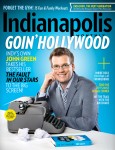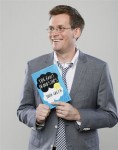John is on the cover of this month's Indianapolis Monthly with a GREAT article about John and his work, namely TFIOS, the movie and most of all, his commitment to nerdfighteria.
Here is an excerpt of the article:
Green had long wanted to write about teenagers living with illness, but without weighing them down in layers of angst or, at the other extreme, painting them as bruised heroes who teach us all an important lesson about being brave. Why couldn’t they just be the same fun, flawed, and complex kids he wrote about in his other novels—the kind of restless youth who play video games in their basements, throw eggs at their exes’ cars, and make out?There are a hundred ways to design that narrative, and Green struggled with several of them. In a a Q&A on his own website, he pointed out that an early, scrapped version of the story centered around a group of kids with cancer who created a club called the Dead Person’s Society that met in a cave. In another draft, he chose a blind character to narrate the story. But all of the right elements started to fall into place when he developed a friendship with a feisty teenager named Esther Grace Earl, an active member of the author’s online fan community whom he first met at a Harry Potter convention. Earl was diagnosed with thyroid cancer at the age of 12 and died four years later, in 2010. A prolific video blogger, she might have influenced Green’s decision to tell his kids-with-cancer story through the spot-on voice of a female narrator. She certainly ignited the book’s theme of short lives lived fully, though Green insists the female character in his book, Hazel Grace Lancaster, is not the fictional version of his friend with the same middle name. When he finished the book, more than a decade in the making, Green—who eventually would help Earl’s parents publish a posthumous collection of her essays through Dutton (a division of Penguin Books)—dedicated The Fault in Our Stars to Earl.It’s a sweet boy-meets-girl story, full of characters who are comfortable in their own skins and possess enviable language skills, elements that resonated with Green’s core readers. But more than any of his other books (none of which, by the way, shy away from heartbreakingly PG-13 motifs), The Fault in Our Stars recalibrated the scales for the teenage love story by retelling the romantic epic in the language of PET scans and G-tubes.By the time he started writing TFIOS, Green had moved back to Indianapolis from New York City, where he and Sarah had lived while she attended grad school at Columbia University. Sarah accepted a position at the Indianapolis Museum of Art in 2007—a great opportunity to work under then-director Max Anderson and senior curator Lisa D. Freiman. “The IMA had this reputation for being the next cool museum to work at,” Green says. “Sarah felt like there would be opportunities for growth, which of course there were. She went from being a curatorial assistant to being a curator in five years.” Indianapolis was also a good place for him to settle into his typical creative mode: blocking out huge chunks of uninterrupted time to write.And Green is no John-Boy Walton when he writes. He becomes irritable and hard to be around (no one wants to go to lunch with him), and the perfect words do not just flow onto the page. He writes with the intention to revise, in rough drafts that he wants someone else to read as soon as he’s done with them. That could be Sarah, at night after they put their two kids (4-year-old Henry and 1-year-old Alice) to bed, or his editor of 11 years, Julie Strauss-Gabel at Dutton Children’s Books, who says that all of his novels endure “a constant back and forth.” And though her client’s public persona is anything but sedate, when it comes to the actual writing, she insists, “he’s always been such a great partner in the quiet craft of working through projects.”But there was nothing quiet about the escalating buzz when word got out about Green’s forthcoming book. The buildup to The Fault in Our Stars’s publishing date hit a feverish pitch when Green promised to sign all 180,000 copies of the work in its first printing—an endeavor that sent him to physical therapy with an “astonishingly painful” elbow condition called ulnar nerve entrapment. He believes his signature changed 2,000 copies in—an unnecessary “h” evolved, and it nearly drove him mad. “I would get paranoid about my signature, because I knew that someone was going to get this book, and they would open it up and be like, ‘Well, that sucks.’ Sometimes I would apologize in parentheses underneath.”But the commitment paid off. The book that Kirkus Reviews described as “a smartly crafted intellectual explosion of a romance” and Time called “damned near genius” has seven million copies in print. And while Green’s books had been optioned for films before, leading nowhere, Hollywood’s interest in this one was more urgent. Director Josh Boone—who had lost a friend to cancer and was struggling with the healing process when he came upon Green’s book—championed the project, and, to Green’s surprise, the wheels quickly started turning.Green’s personal imprint on the book proved so deep and indelible that the author was granted an unusual amount of pull when it came to the film treatment. During the casting phase of The Fault in Our Stars, he lobbied for the relatively unknown Elgort, who auditioned for the male lead of Augustus Waters alongside fellow lanky, soft-featured up-and-comers like Brenton Thwaites, Nat Wolff, Nick Robinson, and Noah Silver. “He didn’t look like Gus in some ways that I felt might be problematic to the audience,” Green says. “But I felt like he understood Gus in such a deep way. I knew I was going to have to sell him. And I feel totally vindicated because he is so great in the movie.”Though the story takes place in Indianapolis, TFIOS was actually filmed in production-friendly Pittsburgh—where the tax credits were worth re-creating local landmarks like the sprawling Funky Bones sculpture at 100 Acres and other details, right down to the Indiana license plates. Green was on-set for much of the filming, and he traveled with the cast and crew when the production took them to the Netherlands for a few pivotal scenes against the real-life backdrop of Amsterdam, including some rare footage shot inside the historic Anne Frank House. The author’s Tumblr, Instagram, and Twitter feeds served as both travelogue and cogs in the movie’s hype machine, whipping up behind-the-scenes excitement. Meanwhile, that clearinghouse of the teen psyche, Hot Topic, came out with a line of T-shirts featuring The Fault in Our Stars lines and imagery, including “Some infinities are bigger than other infinities,” and “Maybe okay will be our always.”Fans got their first glimpse of the movie during a 30-second clip that aired on the Today show in January. Another clip premiered before a live young-adult audience during the MTV Movie Awards, whichGreen attended, wearing a Burberry suit and tweeting a play-by-playfrom the inner sanctum: “David Hasselhoff is sitting seven seats away from me. What?”A whole new audience will get its first taste of “The John Green Experience” when the movie comes out this month and its writer makes the rounds with the publicity dog-and-pony show—the movie junkets and long days spent answering the same questions over and over. He doesn’t like doing TV interviews. He gets nervous and spends too much time fretting and thinking of what to say—like when he went on the Craig Ferguson show last March and couldn’t get any work done for weeks leading up to it. But this time he’s on board with anything 20th Century Fox asks him to do. “If I didn’t like the movie, I wouldn’t do any of that stuff,” says Green, who was treated to a private screening in Los Angeles. “But this is something that I’m really proud of.”In one of the many passages in The Fault in Our Stars that will probably make you cry, 17-year-old Augustus Waters, a former high-school basketball star who lost his right leg to osteosarcoma, grapples with the idea of love and nothingness with such blue-eyed eloquence that Romeo Montague would give him a chest bump at the club: “I know that love is just a shout into the void, and that oblivion is inevitable, and that we’re all doomed and that there will come a day when all our labor has been returned to dust, and I know the sun will swallow the only earth we’ll ever have, and I am in love with you.” Spoiler alert: The theme of oblivion runs throughout the story. But it is also a theme that seems to guide Green in his own life’s storyline, which, much like his Crash Course videos, is at its best when he goes off-script.“My idea was that I would escape oblivion by doing something memorable,” he says. “After my first book, which was my first attempt to grapple with this urge that we all have to be larger than life, I used to ask kids when I would visit high schools how many of them wanted to be famous, deep down. And most of them did. Or they were lying. And I would be like, why? We are very focused on this idea of surviving death. It is not possible—there is 40,000 years of evidence. I have tried to refocus, in my proper adulthood, toward other things.”


























No comments:
Post a Comment